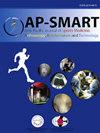Clinical outcomes over 2 years following arthroscopic ankle lateral ligament repair with os subfibulare
IF 1.4
Q3 ORTHOPEDICS
Asia-Pacific Journal of Sport Medicine Arthroscopy Rehabilitation and Technology
Pub Date : 2024-11-26
DOI:10.1016/j.asmart.2024.11.002
引用次数: 0
Abstract
Background
There are reports indicating that between 10 and 38.5 % of patients with chronic lateral ankle instability (CLAI) have an os subfibulare. In cases where CLAI accompanied by os subfibulare is resistant to conservative treatment, surgery may be necessary; however, there is no consensus on the most appropriate surgical method. We report outcomes of arthroscopic lateral ligament repair for chronic lateral ankle instability with os subfibulare at our hospital, followed for over 2 years post-operatively.
Methods
We reviewed 33 patients (39 ankles) whom underwent arthroscopic lateral ankle ligament repair (ALLR) for CLAI and followed for at least 2 years post-operatively between November 2015 and May 2020. Patients were classified into two groups: a group with os subfibulare (ossicle group) and a group without os subfibulare (non-ossicle group), based on the presence of an os subfibulare on pre-operative plain radiographs. ALLR surgeries were performed without resection of the os subfibulare in ossicle group. Clinical outcomes were assessed using the Japanese Society for Surgery of the Foot (JSSF) scale and the Self-administered Foot Evaluation Questionnaire (SAFE-Q). In addition, the bone-union rate was evaluated by using plain computer tomography in the ossicle group.
Results
There were significant improvements in the mean total JSSF scale scores from pre-operative to post-operative measurements in both the ossicle and non-ossicle groups. The mean scores for pain and related symptoms, foot function and activities of daily living, social functioning, shoe-related, and general health and well-being subscales of the SAFE-Q also showed significant improvements in both groups. There were no significant differences between the post-operative ossicle and non-ossicle groups regarding the JSSF scale scores or the SAFE-Q subscale scores. In the ossicle group, the bone-union rate was 14.3 % (2 of 14 ankles), but no symptom recurrence was observed.
Conclusion
The 2 years outcomes of arthroscopic lateral ligament repair for chronic lateral ankle instability with os subfibulare revealed good results and no symptom recurrence.
踝关节镜下踝关节外侧韧带修复术后两年的临床疗效
背景有报告显示,10% 到 38.5% 的慢性外侧踝关节不稳(CLAI)患者伴有腓骨下骨膜。如果慢性外侧踝关节不稳(CLAI)伴有胫骨下骨膜对保守治疗无效,则可能需要进行手术治疗;然而,对于最合适的手术方法还没有达成共识。我们报告了我院对慢性外侧踝关节不稳伴骨骺下畸形进行关节镜下外侧韧带修复术的结果,术后随访超过2年。方法我们回顾了2015年11月至2020年5月期间因CLAI接受关节镜下外侧踝关节韧带修复术(ALLR)的33例患者(39踝),术后随访至少2年。根据术前X光平片上是否存在胫骨腓骨下骨,将患者分为两组:有胫骨腓骨下骨组(ossicle 组)和无胫骨腓骨下骨组(non-ossicle 组)。骨小梁组在不切除骨小梁的情况下进行 ALLR 手术。临床结果采用日本足外科学会(JSSF)量表和自制足部评估问卷(SAFE-Q)进行评估。结果有骨组和无骨组的 JSSF 量表平均总分从术前到术后均有显著改善。两组在SAFE-Q的疼痛和相关症状、足部功能和日常生活活动、社会功能、鞋相关以及一般健康和幸福感分量表的平均得分也都有明显改善。术后有骨组和无骨组在 JSSF 量表评分或 SAFE-Q 分量表评分方面没有明显差异。结论 关节镜下外侧韧带修复术治疗慢性外侧踝关节不稳伴骨骺下闭锁两年后效果良好,无症状复发。
本文章由计算机程序翻译,如有差异,请以英文原文为准。
求助全文
约1分钟内获得全文
求助全文
来源期刊
CiteScore
3.80
自引率
0.00%
发文量
21
审稿时长
98 days
期刊介绍:
The Asia-Pacific Journal of Sports Medicine, Arthroscopy, Rehabilitation and Technology (AP-SMART) is the official peer-reviewed, open access journal of the Asia-Pacific Knee, Arthroscopy and Sports Medicine Society (APKASS) and the Japanese Orthopaedic Society of Knee, Arthroscopy and Sports Medicine (JOSKAS). It is published quarterly, in January, April, July and October, by Elsevier. The mission of AP-SMART is to inspire clinicians, practitioners, scientists and engineers to work towards a common goal to improve quality of life in the international community. The Journal publishes original research, reviews, editorials, perspectives, and letters to the Editor. Multidisciplinary research with collaboration amongst clinicians and scientists from different disciplines will be the trend in the coming decades. AP-SMART provides a platform for the exchange of new clinical and scientific information in the most precise and expeditious way to achieve timely dissemination of information and cross-fertilization of ideas.

 求助内容:
求助内容: 应助结果提醒方式:
应助结果提醒方式:


